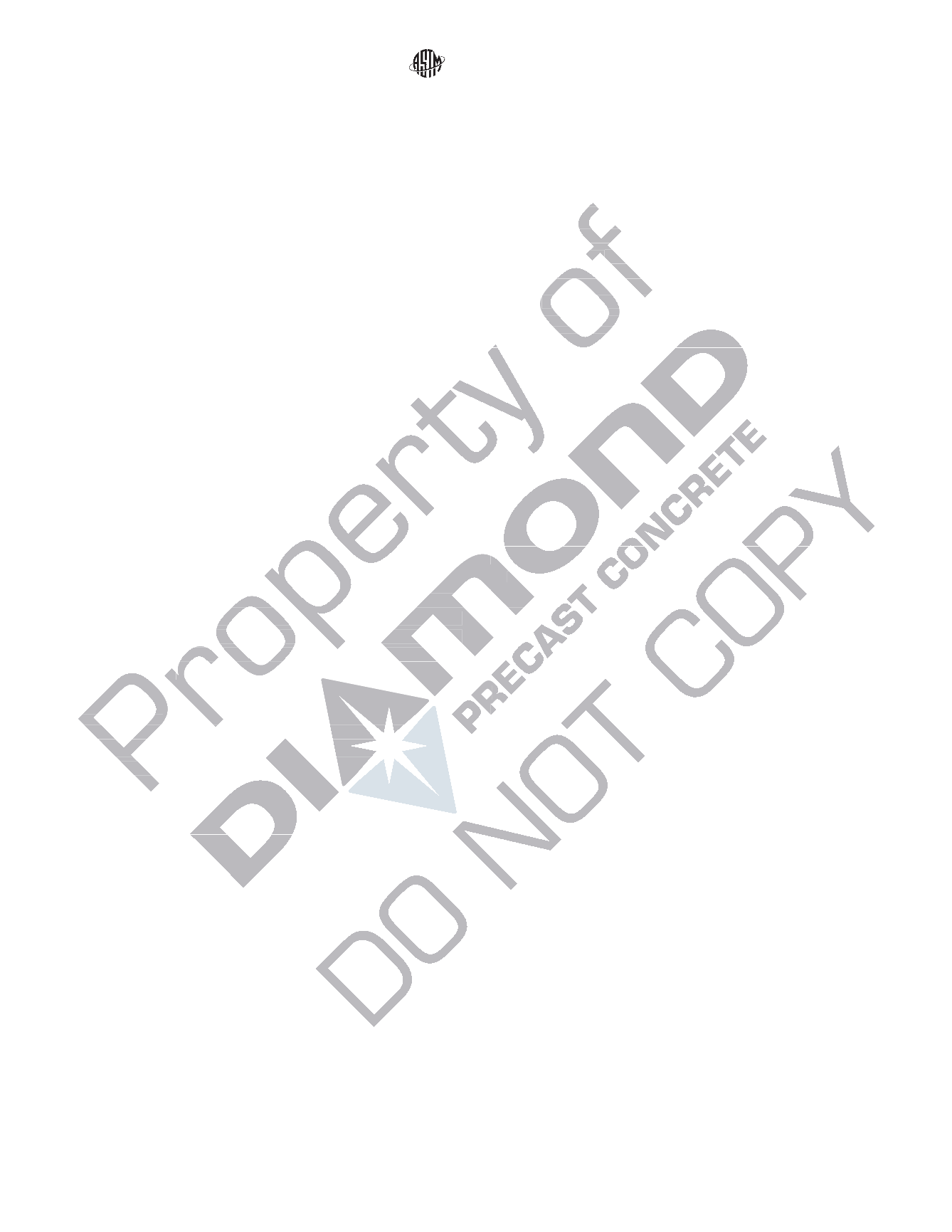

9 % of the dry mass for Test Method A procedure or 8.5 % for
Test Method B procedure. All specimens shall be free of visible
cracks and shall represent the full thickness of the product.
8.2.2.2 Specimens for Test Method B shall meet the require-
ments of Test Methods
C497
.
8.2.2.3 Each specimen tested by Test Method A shall have a
minimum mass of 1.0 kg.
8.2.2.4 When the initial absorption specimen from a con-
crete product fails to conform to this specification, the absorp-
tion test shall be made on another specimen from the same
product and the results of the retest shall be substituted for the
original test results.
8.2.3
Retests—
When not more than 20 % of the concrete
test specimens tested under either
8.2.2.1
or
8.2.2.2
fail to pass
the requirements of this specification, the manufacturer is not
prohibited from culling his stock and eliminating whatever
quantity of product he desires and shall so mark the culled
product that they will not be shipped for the order. The required
tests shall be made on the balance of the order and the products
shall be accepted if in conformance with the requirements of
this specification.
8.3
Test Equipment—
Every manufacturer furnishing man-
hole products under this specification shall furnish all facilities
and personnel necessary to carry out the tests required for
acceptance.
9. Repairs
9.1 Repair of manhole products shall not be prohibited, if
necessary, because of imperfections in manufacture or damage
during handling, and will be acceptable if, in the opinion of the
owner, the repaired products conform to the requirements of
this specification.
10. Inspection
10.1 The quality of materials, the process of manufacture,
and the finished manhole products shall be subject to inspec-
tion and approval by the owner.
11. Product Marking
11.1 The following information shall be legibly marked on
each precast concrete product:
11.1.1 Specification and product designation: MH for man-
hole base, riser, conical tops, and grade rings,
11.1.2 Date of manufacture, and
11.1.3 Name or trademark of the manufacturer.
11.2 Marking shall be indented into the concrete or shall be
painted thereon with waterproof paint.
PART II—PRODUCTS
12. Grade Rings
12.1
Scope—
This section covers precast reinforced concrete
grade rings used for final adjustment of manholes to grade.
12.2
Acceptance—
Acceptability of grade rings covered by
this specification shall be determined by the results of such
tests of materials as are required by Section
4
; by compressive
strength tests on concrete cores or concrete cylinders required
by Section
8
; and by inspection of the finished product,
including amount and placement of reinforcement as pre-
scribed by
12.4
,
12.5
and
12.6
, to determine its conformance
with the design prescribed under this specification and its
freedom from defects.
12.3
Design—
The minimum wall thickness shall be one
twelfth of the internal diameter of the grade ring or 100 mm,
whichever is greater.
12.3.1
Joints—
Grade rings are not required to have the joint
formed with male and female ends.
12.4
Circumferential Reinforcement:
12.4.1 The circumferential reinforcement shall have an
equivalent area of not less than 150 mm
2
/vertical m, but not
less than 15 mm
2
in any one grade ring.
12.4.2 The circumferential reinforcement shall be one line
in the center third of the wall of the grade ring.
12.5
Permissible Variations:
12.5.1
Internal Diameter—
The internal diameter of grade
rings shall not vary more than
6
1 %.
12.5.2
Wall Thickness—
The wall thickness of grade rings
shall be not less than that prescribed in the design by more than
5 % or
6
5 mm, whichever is greater. A wall thickness greater
than that prescribed in the design shall not be cause for
rejection.
12.5.3
Height of Two Opposite Sides—
Variations in laying
heights of two opposite sides of grade rings shall be not more
than 6 mm.
12.5.4
Height of Grade Ring—
The underrun in height of a
grade ring shall be not more than 20 mm/m of height.
12.5.5
Position of Reinforcement—
For grade rings with a
100-mm wall thickness, the maximum variation in the design
position of circumferential reinforcement from that described
in
12.4.1
shall be
6
10 % of the wall thickness or
6
6 mm,
whichever is greater. For grade rings with a wall thickness
greater than 100-mm, the maximum variation from the design
position of reinforcement shall be
6
10 % of the wall thickness
or
6
16 mm, whichever is the lesser. In no case, however, shall
the cover over the reinforcement be less than 19 mm. The
preceding minimum cover limitation does not apply to the
mating surfaces of the joint.
12.5.6
Area of Reinforcement—
Steel reinforcement areas
that are 10 mm
2
/linear m less than called for by design shall be
considered as meeting the required steel reinforcement area.
12.6
Rejection
12.6.1 Grade rings shall be subject to rejection for failure to
conform to any of the specification requirements. In addition,
an individual grade ring shall be subject to rejection because of
any of the following:
12.6.1.1 Fractures or cracks passing through the wall, ex-
cept for a single end crack that does not exceed the depth of the
joint.
12.6.1.2 Defects that indicate mixing and molding not in
compliance with
7.1
or surface defects indicating honey-
combed or open texture that would adversely affect the
function of the grade ring.
C478M − 15
4
Copyright by ASTM Int'l (all rights reserved); Mon Jun 29 17:17:40 EDT 2015
Downloaded/printed by
Jed Friesen (Predl Systems) pursuant to License Agreement. No further reproductions authorized.
















